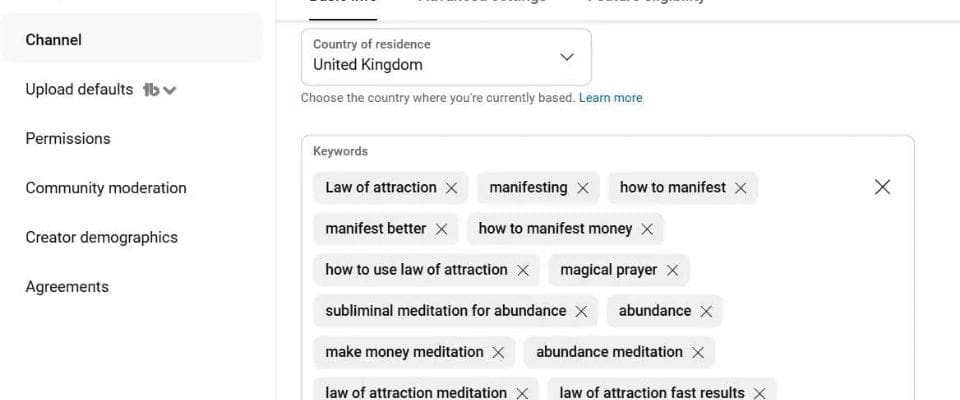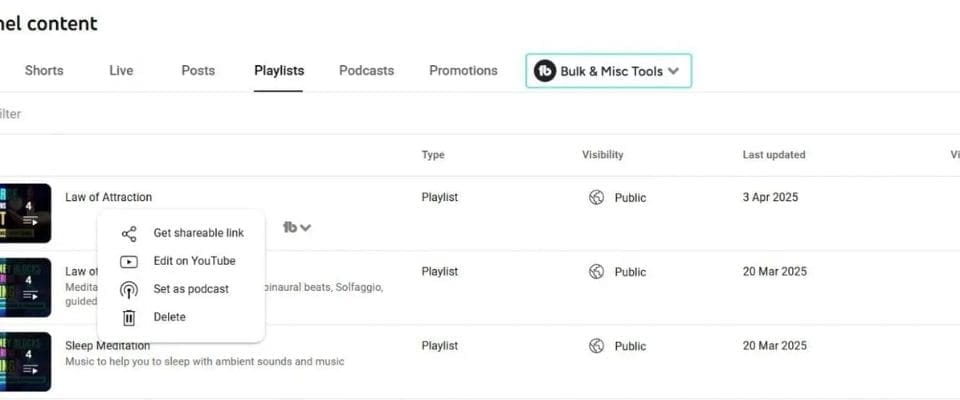Every AI video company online wants to tell you their platform has the best YouTube growth tools to blow up your channel. That makes it a bit of a minefield for us content creators when faced with multiple choices.
With over 2 billion monthly active users and 500 hours of video content uploaded every minute, YouTube has become the world’s most competitive video platform.
Standing out among millions of YouTube channels requires more than just creative content. Above all, it demands strategic use of specialised YouTube growth tools that can optimise your YouTube presence, enhance discoverability, and accelerate subscriber growth.
Primarily, the most successful YouTube creators understand that competing in 2025 and beyond means leveraging data-driven insights, professional-grade production tools, and systematic optimisation strategies.
Whether you’re just starting your YouTube account or looking to scale an existing channel, the right combination of YouTube growth tools can be a game-changer for your channel’s performance. They can help you grow your YouTube channel more effectively than ever before.
This comprehensive guide explores the essential YouTube tools across multiple categories:
- Analytics platforms for tracking engagement metrics
- Content creation software for producing high-quality videos
- SEO tools for keyword research and optimisation
- All-in-one platform solutions that streamline your entire workflow.
Each tool recommendation includes specific pricing details, key features, and practical implementation strategies to help you make informed decisions based on your budget and growth objectives.
Essential YouTube Growth Tools Every Creator Needs
The YouTube platform operates on complex algorithms that prioritise content based on audience engagement, watch time, search relevance, and viewer retention patterns.
To compete effectively, YouTube creators need comprehensive toolkits that address every aspect of channel optimisation, from initial video ideas and content strategy development to detailed analytics and audience insights.

Modern YouTube growth tools fall into several critical categories that work synergistically to maximise your channel’s potential. Analytics tools provide valuable insights into your target audience behaviour, content performance, and competitor strategies.
Video editing and design platforms enable the creation of professional YouTube content that captures attention and maintains viewer interest. SEO and keyword research tools help optimise videos for YouTube search and discovery.
Above all, the most effective approach involves selecting complementary tools that integrate seamlessly into your content creation workflow. Rather than relying on a single solution, successful creators typically use 3-5 specialised tools that address their specific needs and growth stage.
This strategic approach allows for more targeted optimisation while maintaining cost efficiency and avoiding feature overlap.
Understanding when to invest in premium features versus utilising free alternatives is crucial for maximising return on investment. New creators can often achieve significant growth using free tools combined with one or two paid platforms.
At the same time, established channels benefit from comprehensive analytics and automation features that justify higher subscription costs through improved efficiency and results.
Analytics and Performance Tracking Tools
Data-driven decision-making forms the foundation of successful YouTube growth strategies. Without detailed analytics and performance insights, creators operate mindlessly, missing opportunities to optimise content, understand audience preferences, and identify trending topics within their niche.
The following analytics platforms provide the essential metrics and competitive intelligence needed to guide strategic decisions and measure progress toward growth objectives.
VidIQ
VidIQ stands as one of the most comprehensive and affordable YouTube analytics and optimisation platforms, offering real-time keyword tracking, competitor analysis, and trend identification features. Meanwhile, I’ve been using this YouTube growth tool since July 2025, and I’ve already seen results with my new channel.
Read: Is VidIQ worth it
The platform’s Scorecard rates videos based on SEO optimisation, engagement potential, and social sharing likelihood, providing actionable feedback for content improvement.
VidIQ’s keyword research capabilities help identify relevant keywords with optimal search volume, while its trending content alerts keep creators informed about emerging opportunities in their niche.
The platform offers a free browser extension with basic analytics, keyword suggestions, and competitor insights.
Premium plans start at $7.50 monthly for the Pro version, which includes advanced analytics, bulk processing tools, and enhanced keyword research.
The Boost plan at $39 monthly adds competitor tracking, trend alerts, and priority support, making it suitable for serious creators focused on systematic growth.
TubeBuddy
TubeBuddy provides a comprehensive suite of YouTube tools designed to streamline channel management and optimisation processes. The platform excels in bulk processing capabilities, allowing creators to update video metadata, thumbnails, and descriptions across multiple videos simultaneously.
TubeBuddy’s A/B testing features enable systematic optimisation of video titles, thumbnails, and descriptions to maximise click-through rates and engagement.
The tool’s keyword research functionality suggests relevant keywords based on search volume and competition levels, while its tag ranking tracker monitors how videos perform for target keywords over time.
Advanced features include thumbnail generation tools, comment management automation, and detailed audience engagement analytics that reveal optimal posting schedules and content preferences.
TubeBuddy offers a free version with basic optimisation tools and limited bulk processing.
The Pro plan at $9 monthly includes advanced keyword research, A/B testing, and enhanced analytics.
The Star plan at $19 monthly adds competitor insights and priority support, while the Legend plan at $39 monthly provides all features plus advanced automation tools for large-scale channel management.
Social Blade
Social Blade serves as the industry standard for cross-platform analytics, providing comprehensive statistics for YouTube channels, social media accounts, and other content platforms.
The platform offers free access to basic channel statistics, subscriber growth tracking, and estimated revenue ranges based on views and engagement patterns. Social Blade’s historical data allows creators to identify growth trends, seasonal patterns, and the impact of specific content strategies on overall performance.
The platform’s comparison tools enable creators to benchmark their performance against similar channels in their niche, identifying gaps and opportunities for improvement.
Social Blade’s projected growth calculator helps set realistic goals and track progress toward subscriber milestones, while its trending video tracker highlights viral content across different categories and regions.
Content Creation and Video Production Tools
High-quality videos form the cornerstone of successful YouTube channels, requiring professional-grade tools that enable creators to produce engaging content efficiently.
Modern content creation platforms integrate artificial intelligence, automated editing features, and extensive asset libraries to streamline production workflows while maintaining broadcast-quality standards.

InVideo
InVideo specialises in YouTube-specific content creation, offering over 5,000 professionally designed templates optimised for different video formats and niches. The platform’s strength lies in its YouTube templates that include video intros, outro sequences, and complete video layouts designed to maximise audience engagement and watch time.
InVideo’s stock footage library contains millions of clips, images, and background music tracks, eliminating the need for separate asset subscriptions.
The platform’s AI-powered script-to-video feature converts written content into fully produced videos with automated scene selection, text overlays, and music synchronisation. This capability significantly reduces production time while maintaining professional quality standards.
InVideo also provides brand kit functionality, allowing creators to maintain a consistent visual identity across all YouTube content.
Pricing starts at $30 monthly for the Plus plan, which includes unlimited video exports, premium templates, and commercial usage rights.
The Max plan at $60 monthlyadds advanced features like voice-over recording, team collaboration tools, and priority support.
The Generative AI Plan is the deluxe sooper dooper video creation plan, with incredible AI video creation. It’s one of the most effective YouTube growth tools. I can’t justify the cost of this for myself, but I will add it as soon as I can.
CapCut
CapCut has had some criticism over the years, but it’s hands down the easiest video editing software for beginners. There’s practically no learning curve if you have half a brain.
CapCut used to offer a lot with the free version, but after they took away the free captions, we had little choice but to upgrade to a paid account. That said, it’s $9.99 per month or $89 per year for the subscription. For that cost, it’s certainly worth it.
It can be a little resource hungry, but recently I discovered how to clear the cache in settings and gained back 18GB of space on my laptop.
Canva
Canva revolutionises thumbnail creation and channel branding with its intuitive design interface and YouTube-specific templates. Research consistently shows that optimised thumbnails can increase click-through rates by up to 50%, making Canva an essential tool for YouTube creators.
The platform provides thumbnail templates designed for various niches, trending styles, and seasonal themes, along with extensive libraries of stock photos, graphics, and fonts. That said, I use Canva AI to create most of my images for thumbnails, using ChatGPT to provide the prompts.
Royalty-Free Music
Hands down, the best platform for royalty-free music is Uppbeat. I’ve been a member for several years, starting with the free plan, which is super generous. I upgraded in 2024 because I needed more music.
It’s super affordable with a vast range of music genres. You can whitelist up to 3 channels for less than £7
Check out my review on Uppbeat.
How to Implement YouTube Growth Tools for Maximum Growth
Effective implementation of YouTube growth tools requires systematic integration into existing workflows, proper measurement protocols, and regular optimisation based on performance data.
The following step-by-step approach ensures maximum value from tool investments while avoiding common implementation mistakes that limit effectiveness.
Phase 1: Foundation Setup (Week 1-2)
Begin by establishing comprehensive analytics tracking using YouTube Studio and one premium analytics platform like VidIQ or TubeBuddy. Configure goal tracking for subscriber growth, watch time improvement, and engagement rate optimisation.
Set up keyword research workflows using both free and paid tools to identify content opportunities within your niche.
Remember, you don’t have to subscribe to all the YouTube growth tools. VidIQ and InVideo are two that I recommend for optimising your efforts. After all, if you’re a new blogger or vlogger, you don’t have a bottomless budget (yet).
Install browser extensions for chosen optimisation tools and configure automated tracking for competitor channels and trending content in your category.
Establish baseline metrics for current channel performance, including:
- Average view duration
- Click-through rates
- Subscriber conversion rates from different traffic sources
Phase 2: Content Optimisation (Week 3-4)
Implement systematic keyword research for new video ideas using the established tool stack. Create templates for video titles, descriptions, and tags that incorporate target keywords naturally while maintaining audience appeal. ChatGPT is handy for these aspects.
Begin A/B testing different thumbnail styles (you can upload three at a time) and video titles. That helps you to identify the highest-performing approaches for your specific audience. I gained a lot of tips about thumbnails from VidIQ and wrote an article on tips for YouTube growth.
Establish quality control processes for video production using chosen editing and design tools. Create brand guidelines for thumbnails, intro sequences, and visual consistency that differentiate your content from competitors while maintaining professional standards.
Phase 3: Workflow Automation (Week 5-6)
Configure bulk processing tools for metadata optimisation across existing videos, focusing on underperforming content that could benefit from improved SEO. Set up scheduling systems that align video uploads with optimal audience activity periods identified through analytics tools.
Phase 4: Performance Monitoring (Ongoing)
Create monthly optimisation routines that include competitive analysis, trend identification, and content gap assessment using your chosen analytics platforms. Track ROI from tool investments by monitoring improvements in key metrics like organic discovery, search rankings, and audience engagement.
Common implementation mistakes include over-optimising content at the expense of authenticity. Avoid relying too heavily on keyword density without considering audience value, and failing to adapt strategies based on performance data.
Successful creators maintain a balance between optimisation and genuine audience service, using tools to enhance rather than replace creative decision-making.
Expected timelines for seeing results vary by tool category and implementation consistency. Analytics and SEO improvements typically show impact within 2-4 weeks. Audience growth and engagement improvements may require 2-3 months of consistent optimisation.
The key to sustainable growth lies in the following:
- Using the right YouTube tools for your channel
- High-quality content creation that serves genuine audience needs and interests.
Conclusion
In conclusion, successful YouTube growth requires strategic tool selection, systematic implementation, and continuous optimisation based on performance data. The best YouTube growth tools provide the insights, efficiency, and capabilities needed to compete effectively in 2025’s competitive landscape.
Firstly, start with free alternatives to establish workflows and understanding. Secondly, when you can afford it, invest in premium tools that address your specific growth bottlenecks and scaling objectives.
Remember that tools amplify good content strategy but cannot substitute for understanding your audience and creating valuable content. Don’t try to beat the algorithm. Focus on making content your audience enjoys.
Above all, the most successful YouTube creators use these platforms to enhance their natural creativity and audience connection, not replace it.
Focus on building genuine relationships with your viewers. Meanwhile, leverage these powerful optimisation tools to ensure your content reaches and resonates with your intended audience.
Disclaimer: This post contains affiliate links. I may earn a commission if you sign up for a program or make a purchase using my link


















